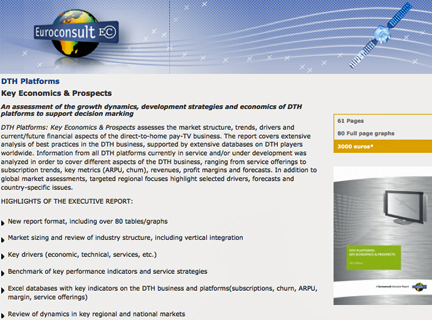More than 150 platforms with TV revenues primarily derived from direct-to-home satellite broadcasting are now offering services. The 202 million DTH subscribers in over 100 countries (early in 2013) will result in more than $100 billion in revenues this year. Although the report highlights large national specificities, three market profiles with different growth patterns and service availability can be identified:
Advanced markets such as the US, UK, France and Japan have a high payTV maturity and see fierce competition resulting from telecom and media convergence and online entertainment In transitional markets, payTV penetration is reaching over 50 percent and consolidation is taking place among pay-TV providers in order to reach critical size and solid operating margins.
Emerging and fast growing DTH markets had 126 million subscribers and 20 percent growth last year. Strong competition exists among platforms with up to six or seven services in countries like India and Indonesia. The report benchmarks commercial strategies and economic performance of DTH platforms, and provides a number of key findings and items to support future development priorities.
“In a highly competitive environment, content stays at the heart of the development model,” said Pacôme Revillon, CEO of Euroconsult. “Excluding new platforms, the standard offering now stands at 100-150 channels, with around 25 percent of platforms offering more than 150 channels.” Emphasis is given to proprietary content and channels, and for securing premium TV rights, resulting in higher programming costs, usually representing over 40 percent of operating costs and 30 to 40 percent of revenues.
High definition (HD) is becoming a must-have for DTH platforms worldwide. Two thirds of platforms now offer HD content, and the number of platforms with more than 20 HD channels more than doubled in the last two years. SKY Perfect JSAT in Japan should become the first HD-only platform by 2015. Although HD penetration already reaches up to 40-60 percent of subscribers for certain players, it still remains a niche service in many fast growing economies.
While platforms in advanced markets target ARPUs of more than $40-50, subscriptions and strategies are now turned to low cost services, particularly in emerging digital markets. Entry prices of no more than a few dollars per month result for many platforms in ARPU of around $10 or less. However, low cost strategies allowed Tricolor TV in Russia and Multichoice in South Africa to sign a total of 12 million subscribers in five years.
Vertical integration and converging service ecosystems is the third major trend for DTH platforms; it includes three pillars. The rollout of new generation DVRs with up to 1 TB storage capability and more flexibility in home networking is a first component. The second is the rollout of non-linear services with VoD (online and push-VoD) by already more than two thirds of DTH platforms, TV everywhere/on the go and OTT services. The need to offer triple play services leads to different strategies, ranging from the ownership of DTH services by telecom operators (more than 60 percent of platforms in Latin America), to direct investments in telecom operations (Sky Digital in the UK or Bulsatcom in Bulgaria) and partnership oriented strategies (DirecTV in the US and Canal+ in France).
Service strategies allowed platforms to maintain churn rates between 10% and 20%, with best performing platforms reducing their churn rates in recent years such as Astro in Malaysia, Cyfrowy Polsat in Poland and Sky Deutschland in Germany.
DTH subscriptions should reach close to 350 million in 2022 worldwide including around 270 million in fast growing economies. Asia, led by India and Indonesia and Latin America, led by Brazil and Mexico, are expected to be the fastest-growing markets. In these, subscriptions should continue to be supported by low-cost offerings and the roll-out of new services. The need to minimize entry fees to develop a market should put growing pressure on DTH platforms’ economic models with revenues expected to reach $130 billion by 2022.
About the report
DTH Platforms: Key Economics & Prospects assesses the market structure, trends, drivers and current/future financial aspects of the direct-to-home payTV business. The report covers extensive analysis of best practices in the DTH business, supported by extensive databases on DTH players worldwide. Information from all DTH platforms currently in service and/or under development was analyzed in order to cover different aspects of the DTH business, ranging from service offerings to subscription trends, key metrics (ARPU, chum), revenues, profit margins and forecasts. In addition to global market assessments, targeted regional focuses highlight selected drivers, forecasts and country-specific issues.


